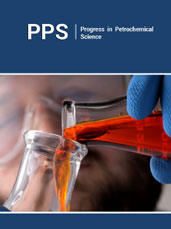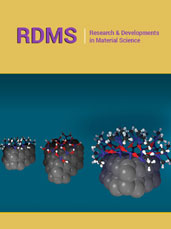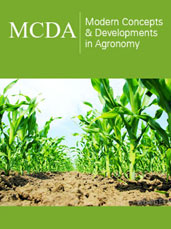- Submissions

Full Text
Progress in Petrochemical Science
Optimization of Bioethanol Production from Yam (Dioscorea spp.) by Acid Hydrolysis and Fermentation Process
Daniel Eke Ogboso*, Isah Mohammed Alkali, Jennifer Emuakponayeri Onoedafe and Tchere Ahmat Younous
Department of Chemical Engineering, Ahmadu Bello University, Nigeria
*Corresponding author:Daniel Eke Ogboso, Department of Chemical Engineering, Ahmadu Bello University, Nigeria
Submission: January 23, 2025;Published: February 06, 2025

ISSN 2637-8035Volume6 Issue 5
Abstract
With growing global energy demands and the environmental consequences of fossil fuel dependency, there is a critical need to develop sustainable and renewable energy alternatives. This study aims to optimize the process conditions for bioethanol production from yam (Dioscorea spp.) using acid hydrolysis and fermentation. Fresh yam tubers were processed to extract starch, which was hydrolyzed using sulfuric acid at varying concentrations (0.5M, 1.5M and 2.5M) and neutralized to different pH levels (4.5, 5.5 and 6.5). The hydrolysates were then fermented with Saccharomyces cerevisiae under controlled conditions for durations of 2, 3.5 and 5 days. Ethanol was recovered through distillation and characterized by specific gravity and purity. The results indicated that the highest ethanol yield (10.8mL, 2.7% v/v) was achieved at an acid concentration of 1.5M, pH 5.5 and a fermentation duration of 3.5 days. This optimal yield highlights the critical role of balanced acid concentration and pH in maximizing hydrolysis efficiency and fermentation activity, while prolonged fermentation led to diminishing returns due to inhibitory by-products. These findings align with previous studies, underscoring the efficiency of moderate conditions for bioethanol production. The study concludes that yam starch is a viable feedstock for bioethanol production, provided optimal process parameters are maintained. Further investigations could explore broader parameter ranges and employ modeling techniques to enhance process efficiency and scalability.
Keywords:Bioethanol; Yam (Dioscorea spp.); Fermentation; Renewable energy; Acid hydrolysis
Introduction
Rapid industrial growth has created an urgent need for energy sources that are environmentally sustainable [1]. The 21st century is marked by critical challenges, such as the depletion of fossil fuel reserves, a significant rise in greenhouse gas emissions contributing to global warming, and the increasing difficulty in meeting the world’s growing energy demands. About 170 quads of the more than 460 quads of energy utilized worldwide come from petroleum, which is a significant amount more than comes from other sources. International interest in alternative fuels has significantly increased despite the detrimental effects of fossil fuels on global warming and policymakers have set high goals for alternate sources of energy as a result of the unstable oil price and political unrest in oil-producing nations [2]. In trying to reduce the impact of these global concerns, another renewable energy source; biofuels are preferred [3]. Bioethanol derived from renewable resources, such as biomass, has garnered considerable attention as a sustainable energy source. It is regarded as an effective solution for renewable energy. Given the potential of bioethanol to help create a cleaner environment, along with the enforcement of environmental protection regulations in numerous countries, the demand for efficient bioethanol production methods is likely to rise. While ethanol production is a long-established process, its role as a liquid fuel presents certain challenges. It was one of the earliest fuels utilized in automobile engines and gained significant use during World War II, particularly in Germany, Brazil, the Philippines and the United States [4,5]. Following the war, the widespread availability and affordability of petroleum caused gasoline to dominate the automotive fuel market. However, during the oil crises of the 1970s, ethanol re-emerged as a viable alternative or blending agent to extend petroleum-based fuel supplies [6].
Biochemical processes convert biomass into bioethanol, a renewable fuel [7]. Its production typically involves three main stages: hydrolysis, fermentation and distillation [8]. Starch from biomass feedstocks, including macroalgae, lignocellulosic materials and cereal grains, is hydrolyzed to produce fermentable monosaccharide sugars. The next step is fermentation, in which microbes-specifically, Saccharomyces cerevisiae yeast-enable chemical reactions in a substrate rich in sugars under either anaerobic or aerobic conditions, thereby turning the sugars into ethanol [9]. Distillation, the last stage, is a thermochemical separation procedure that uses variations in boiling points during heat application to concentrate ethanol to a 95% purity level [7,8]. Table 1 provides a summary of the bio-ethanol’s characteristics that enable its use in the motor fuel sector as well as each benefit. To produce bioethanol, biomass feedstocks like wheat, barley, sorghum, rice, corn and sugarcane are frequently used and have demonstrated success [10]. The dependence on these crops, however, raises questions about their availability as necessary sources of feed and food. To overcome this, bioethanol is produced from alternate sources, such as industrial waste and agricultural leftovers, including switchgrass, barley straw, husks and sugarcane bagasse. Due to their high lignocellulosic content, these residues frequently necessitate laborious and time-consuming pretreatment procedures [11].
Table 1:Merits of bioethanol as a fuel.

Yam (Dioscorea spp.) was chosen as the substrate for this study due to its high starch content, which is ideal for bioethanol production [12]. Although yam is a staple food crop in many regions, it is often subject to post-harvest losses, particularly in developing countries, due to inadequate storage and preservation facilities [13]. Utilizing surplus or non-marketable yam tubers for bioethanol production offers a sustainable approach to minimizing waste while generating renewable energy. Additionally, yam’s availability in large quantities, especially in yam-producing regions like Nigeria, ensures that its use as a bioethanol feedstock does not significantly impact food security. This aligns with the global need to balance industrial use of agricultural resources with food sustainability [10]. Furthermore, different process conditions influence the eventual yield of bioethanol. The reactor conditions such as temperature, substrate concentration, pH, have direct effect on ethanol yield. Other parameters include presence of oxygen, fermentation duration, culture age, inorganic nutrient supplementation [14]. Ethanol has been known to be produced from fossil fuel. With the adverse effects of fossil fuel processing, there is need to source better, cheaper, more available and environmentally safe options like maize, cassava, yam tuber, etc. There is also the need to optimize process conditions to ensure maximum yield as these agricultural sources have alternate uses in feeding.
Materials and Methods
Materials
Fresh Diascorea rotundata tubers were gotten from Ihiagwa Market in Ihiagwa, Owerri West Local Government Area, Imo State Nigeria. The baker’s yeast was purchased from a commercial market in Aba, Abia State Nigeria.
Chemicals
The chemicals utilized in this study include sulfuric acid, distilled water, Luff-Schoorl solution, sodium thiosulfate, sodium carbonate, lead acetate and yeast (Saccharomyces cerevisiae).
Starch extraction
Fresh yam tubers were washed, peeled and sliced into chips, then soaked in water for 30 minutes. The chips were milled into pulp and sieved through a 25-micron mesh to separate fibrous materials. The resulting starch milk was allowed to settle for 4-6 hours, after which the supernatant was decanted and the starch residue was collected.
Optimization of acid hydrolysis process: acid concentration and duration
The starch slurry was hydrolyzed using sulfuric acid at concentrations of 0.5M, 1.5M and 2.5M. Each 100mL of starch slurry was combined with 100mL of the prepared acid solutions. Hydrolysis was performed at 100 °C for 30 minutes on a hot plate stirrer [15]. The hydrolysates were cooled and neutralized to pH values of 4.5, 5.5 and 6.5 using NaOH solution. The glucose concentration resulting from the hydrolysis process was measured using the Luff-Schoorl method [16].
Fermentation process
The neutralized hydrolysates were subjected to submerged fermentation. This method was selected due to its efficiency in handling liquid substrates and compatibility with the yeast species used, Saccharomyces cerevisiae. A 10% (v/v) inoculum of the yeast was introduced into the hydrolysates and fermentation was conducted under anaerobic conditions at room temperature for 2, 3.5 and 5 days. The pH was monitored daily to maintain the fermentation range. After fermentation, the hydrolysates were distilled at 78-90 °C using a distillation setup with a heating mantle and Liebig condenser. Ethanol was collected and analyzed for specific gravity and purity.
Distinguishing test for ethanol
Ethanol production was confirmed using the Iodoform Test. This qualitative test involved adding iodine solution and sodium hydroxide to the distillate. The formation of a pale-yellow precipitate of iodoform confirmed the presence of ethanol. Quantity of ethanol produced was measured using a 100ml Pyrex measuring cylinder. The specific gravity of the distillate was determined using a density bottle. The ethanol sample was placed in a specific gravity bottle and its weight was measured and documented. The bottle was filled with distilled water, its weight was measured and recorded. The specific gravity was then determined using the following method:

Other runs
The experiment was repeated with same procedure for fermentation of 3,5 days and 5 days.
Result and Discussion
Variables used
The plots and analyses in this study examine the impact of three critical process variables on ethanol yield: sulfuric acid concentration (0.5M, 1.5M and 2.5M), pH levels (4.5, 5.5 and 6.5) and fermentation durations (2, 3.5 and 5 days). These variables were systematically varied to determine their individual and combined effects on the efficiency of hydrolysis and fermentation processes, with the aim of identifying the optimal conditions for maximizing ethanol production (Table 2).
Table 2:Process variables.

Optimization of glucose yield from acid hydrolysis at varying sulfuric acid concentrations
The monosaccharide (glucose) content resulting from the hydrolysis process was determined using the Luff-Schoorl method. This method is based on an oxidation-reduction reaction between glucose and the Luff-Schoorl reagent. It involves an indirect titration, where the reaction liberates iodine from potassium iodide, which is then titrated with sodium thiosulfate. A starch indicator was used to identify the titration endpoint [16] (Table 3). The results from the acid hydrolysis process reveal a clear relationship between sulfuric acid concentration and glucose yield. At a low acid concentration of 0.5M, a moderate glucose concentration of 12.5% was observed, likely due to limited hydrolytic efficiency under mild conditions. The optimal glucose yield (25.4%) was achieved at 1.5M sulfuric acid, which aligns with findings in existing literature suggesting that moderate acid concentrations strike a balance between efficient starch hydrolysis and minimal sugar degradation [7]. However, at 2.5M acid concentration, the glucose yield decreased to 18.2%, indicating that higher acid concentrations may lead to sugar degradation into inhibitory compounds such as furfural and hydroxy methyl furfural. These findings demonstrate the importance of optimizing acid concentration to maximize glucose availability for subsequent fermentation processes, supporting the highest ethanol yield reported in this study at 1.5M sulfuric acid.
Table 3:Glucose concentrations obtained from acid hydrolysis at different sulfuric acid concentrations.

Ethanol volume analysis
The effect of the process parameters; Acid concentrations for hydrolysis, time and pH, on the yield of ethanol are considered.
Variation of ethanol yield with acid concentration: The following plots below depict the variation in ethanol yield as a function of sulfuric acid concentration (0.5M, 1.5M and 2.5M) at different pH values and fermentation durations. These results provide insights into the optimal acid concentration for hydrolysis, where maximum fermentable sugar production and ethanol yield are achieved without significant degradation into inhibitory byproducts. Figure 1-3 are the graphical plots of ethanol yield against acid concentrations at different pH values across fermentation durations of 2 days, 3.5 days and 5 days. A clear inspection of the plots above revealed that for all fermentation durations and pH values, the ethanol yield was highest at the acid concentration of 1.5M, underscoring the critical role of moderate acid concentration in maximizing ethanol production.
Figure 1:A plot of ethanol yield versus acid concentration for 2 days run at different pH levels.

Figure 2:A plot of ethanol yield versus acid concentration for 3.5 day run at different pH levels.

Figure 3:A plot of ethanol yield versus acid concentration for 5 days run at different pH levels.

In Figure 1, a clear inspection shows that for pH of 4.5 and 6.5, the ethanol yield is lowest at the acid concentration of 0.5M and highest at 1.5M being intermediate for 2.5M. The difference however between that of 1.5M and 2.5M is much smaller than that between 0.5M and 1.5M. This suggests that 1.5M acid concentration achieves optimal starch hydrolysis, facilitating the production of fermentable sugars while minimizing the degradation of sugars into inhibitory by-products such as furfural and Hydroxy Methyl Furfural (HMF). Figure 2 also shows that the ethanol yield at concentration of 1.5M was the highest for pH values of 5.5 and 6.5. The results for the pH value of 4.5 showed steady increase throughout the range of concentration values. This is a notable deviation and may be attributed to unique fermentation dynamics at this pH, potentially involving variations in enzyme activity or yeast metabolism. Such deviations have been noted in the work of Demirbas A [7], where specific process parameters influenced hydrolysis and fermentation
Figure 3 follows the general trend observed in Figure 1 & 2, with ethanol yield peaking at 1.5M acid concentration across all pH values. The results for the 5-day fermentation confirm that prolonged durations do not alter the optimal acid concentration for maximum yield. Instead, extended fermentation may lead to slight decreases in yield due to the accumulation of inhibitory metabolic by-products. It can be generally concluded that the optimum pH for ethanol yield occurs at the acid concentration of 1.5M for all pH ranges and number of days. These findings align with the results reported by Ezejiofor TI et al. [12], who demonstrated that moderate acid concentrations optimize sugar production while preventing excessive sugar degradation. Similarly, Akponah E et al. [15] emphasized that maintaining balanced hydrolysis conditions at 1.5M acid concentration enhances substrate conversion efficiency and supports robust yeast activity. Figure 4-6 show the variation of ethanol yield with acid concentration at different fermenting duration. They are alternative ways of showing the variation of ethanol yield with acid concentration at different pH values. The optimal yield of ethanol still holds at 1.5M over the pH and fermentation duration range.
Figure 4:A plot of ethanol yield versus acid concentration for pH value of 4.5 at fermentation duration.

Figure 5:plot of ethanol yield versus acid concentration for pH value of 5.5 at fermentation duration.

Figure 6:plot of ethanol yield versus acid concentration for pH value of 6.5 at fermentation duration.

Variation of ethanol yield with pH: The plots illustrate the influence of pH (4.5, 5.5 and 6.5) on ethanol yield under varying acid concentrations and fermentation durations. The data highlight the pH conditions that optimize the activity of Saccharomyces cerevisiae, ensuring efficient fermentation and ethanol production while minimizing bacterial interference and enzymatic inhibition. The results presented in Figure 7-9 illustrate the variation of ethanol yield as a function of pH at different acid concentrations across varying fermentation durations. A common trend was observed where maximum ethanol yields were predominantly achieved at a pH of 5.5. This observation aligns with the findings of Akponah E et al. [15], who reported that ethanol-producing microorganisms, particularly Saccharomyces cerevisiae, thrive optimally in slightly acidic conditions within the pH range of 4.0-5.5. The ability of yeast to tolerate lower pH values minimizes bacterial contamination, thereby enhancing ethanol productivity.
Figure 7:A plot of ethanol yield versus pH for 2 days run at different values of acid concentration.

Figure 8:A plot of ethanol yield versus pH for 3.5 day run t different values of acid concentration.

Figure 9:Plot of ethanol yields versus pH for 3.5 day run at different values of acid concentration.

In Figure 7, the clear relationship between ethanol volume and pH during the 2-day fermentation shows a pronounced peak at pH 5.5 for all acid concentrations tested. This trend corroborates the work of Uma R et al. [11], who isolated S. cerevisiae from palm wine and observed its increased ethanol production at pH levels around 5.5. The consistency of these findings suggests that a pH value of 5.5 creates an ideal environment for enzymatic activity and fermentation efficiency, ensuring robust microbial metabolism. For the 3.5-day fermentation shown in Figure 8, slight deviations from the pattern were recorded. While an acid concentration of 0.5M maintained a clear optimum at pH 5.5, higher acid concentrations (1.5M) resulted in an extended yield plateau spanning pH values 5.5-6.5. This behavior may be attributed to substrate availability and delayed inhibition of yeast activity under mildly neutral conditions, as previously noted by Renu D et al. [17]. Conversely, at 2.5M acid concentration, a steady decline in ethanol yield was observed, with the highest yield occurring at pH 4.5. This result suggests that high acid concentrations may have inhibited enzymatic hydrolysis or negatively impacted yeast viability at higher pH levels, a phenomenon also reported by Lenihan P et al. [18] during acid hydrolysis processes.
Figure 10:A plot of ethanol yield versus pH for 0.5M acid concentration at different fermentation duration.

The results for the 5-day fermentation run, as shown in Figure 9, further emphasize the dominance of pH 5.5 as the optimum condition for ethanol yield. Acid concentrations of 1.5M and 2.5M maintained their peak yields at this pH value, reinforcing findings by Ok T et al. [19], who demonstrated that yeast isolates tolerate and perform efficiently at moderately acidic pH. However, the anomaly observed at 0.5M acid concentration, where ethanol yield was lowest at pH 5.5, may be attributed to experimental errors or measurement inaccuracies, as highlighted in your results. Measurement inconsistencies have previously been documented as a limitation in bioethanol studies involving acid hydrolysis and fermentation processes [8]. Generally, these findings demonstrate a clear optimum pH value of 5.5 for maximizing ethanol yield across varying acid concentrations and fermentation durations. This is consistent with the results of Sanchez OJ et al. [9], who emphasized that pH levels close to 5.5 create favorable conditions for enzymatic activity, sugar metabolism and ethanol production. Furthermore, the observed deviation in ethanol yields at higher acid concentrations suggest that process optimization must consider acid inhibition effects, as reported in earlier studies on bioethanol production using concentrated and dilute acid hydrolysis processes [20]. Figure 10-12 show the variation of ethanol yield with Ph at different fermenting durations. They are alternative ways of showing the variation of ethanol yield with pH at different acid concentrations. The optimal yield of ethanol still holds at pH value of 5.5 over the acid concentration and fermentation duration ranges.
Figure 11:A plot of ethanol yield versus pH for 1.5M acid concentration at different fermentation.

Figure 12:A plot of ethanol yield versus pH for 2.5M acid concentration at different fermentation.

Variation of ethanol yield with time (fermentation duration): The relationship between fermentation duration (2, 3.5 and 5 days) and ethanol yield is presented in the following plots below. The results emphasize the time-dependent dynamics of fermentation, showcasing the point at which ethanol production is maximized before inhibitory effects, such as ethanol toxicity and substrate depletion, become significant. Figure 13-15 are the graphical plots of ethanol yield against fermentation duration at different pH values. In Figure 13, ethanol yield is seen to be maximum at 5 days for pH values of 4.5 and 6.5. The results for pH value of 5.5 showed little changes in the yield of ethanol across all pH values. From the graph of Figure 14, ethanol yield is seen to be at maximum values for fermentation duration of 3.5 days for pH values of 5.5 and 6.5. The results for pH value of 4.5 showed almost constant ethanol yield for all pH values. For 2.5M as seen in Figure 15, ethanol yield showed a clear optimum value at 3.5 days for all pH values.
Figure 13:A plot of ethanol yield versus fermentation duration for 0.5M acid concentration at different pH values.

Figure 14:A plot of ethanol yield versus fermentation duration for 1.5M acid concentration at different pH values.

Figure 15:A plot of ethanol yield versus fermentation duration for 2.5M acid concentration at different pH values.

The overall results reveal that ethanol yield is generally highest at a fermentation duration of 3.5 days, regardless of the pH value or acid concentration. This optimum duration is likely due to the balance between microbial growth, substrate consumption and product accumulation. The findings are in agreement with the study by Kumar A et al. [2], which demonstrated that the exponential growth phase of Saccharomyces cerevisiae reaches its peak ethanol production within 72-96 hours under optimal conditions. Beyond this point, factors such as ethanol inhibition and nutrient depletion may hinder further increases in yield. Thus, optimizing fermentation duration to 3.5 days could significantly enhance ethanol production efficiency, provided that pH and acid concentrations are appropriately managed. Future studies could explore additional variables, such as substrate loading and temperature, to further refine ethanol production conditions. Figure 16-18 show the variation of ethanol yield with pH at different fermenting durations. They are alternative ways of showing the variation of ethanol yield with pH at different acid concentrations. The optimal yield of ethanol still holds at pH value of 5.5 over the acid concentration and fermentation duration ranges.
Figure 16:A plot of ethanol yield versus fermentation duration for 4.5pH at different acid concentrations.

Figure 17:A plot of ethanol yield versus fermentation duration for 5.5pH at different acid concentrations.

Figure 18:A plot of ethanol yield versus fermentation duration for 6.5pH at different acid concentrations.

Total optimum yield
The general total optimum yield of ethanol production corresponds to the highest volume of ethanol recorded throughout the experiment. The process conditions for this optimum value are a combination of the singular optimum conditions discussed earlier (Table 4). The table above shows the general optimum found over the temperature range. The result of the experiment shows that all the process variables directly affect the volume of ethanol produced (Figure 19-21). The highest ethanol volume (10.8ml, 2.70 %v/v) was observed at 1.5M acid concentration, 5.5 pH and 3.5days fermenting duration. The optimal concentration is in agreement with result obtained by Ezejiofor TI et al. [12]. The average yield of ethanol from acid concentration of 0.5M was 6.98ml while that of 2.5M was 8.29ml as against 9.02ml gotten for 1.5M.
Table 4:Optimal process conditions.

Figure 19:A response surface plot of ethanol yield at optimum duration.

Figure 20:A response surface plot of ethanol yield at optimum acid concentration.

Figure 21:A response surface plot of ethanol yield at optimum pH.

The fermentation rates were influenced by the prevailing pH, with pH 5.5 identified as the optimal level for ethanol production. The average ethanol volume produced at this pH value was 8.91ml. Other pH values produced significantly lesser volume of ethanol (7.56ml and 7.82ml for 4.5 and 6.5pH respectively). This pH level is likely optimal for the growth of the tested Saccharomyces cerevisiae isolate and may have provided the most favorable conditions for its fermentative activities. Benerji DS et al. [21] observed that Saccharomyces cerevisiae thrives optimally in a slightly acidic pH environment. This finding is consistent with results reported by Akponah E et al. [15]. The fermentation experiment in this study showed that ethanol production initially increased before declining slightly, with the peak occurring at 3.5 days. The average ethanol yield at 3.5 days was 8.39mL, marginally higher than the 8.09mL observed after 5 days and significantly greater than the 7.36mL recorded at 2 days. These findings align with the results reported by Akponah E et al. [15]. The observed decline in ethanol production could be attributed to the accumulation of toxic by-products in the fermentation medium and the inhibitory effects of increasing ethanol concentration [22-38].
Conclusion
This study successfully optimized the process parameters for bioethanol production from yam (Dioscorea spp.) using acid hydrolysis and fermentation. The findings revealed that an acid concentration of 1.5 M, pH 5.5 and a fermentation duration of 3.5 days yielded the maximum ethanol output of 10.8mL (2.7% v/v). These optimal conditions strike a balance between efficient hydrolysis and fermentation, minimizing inhibitory by-products and maximizing ethanol production efficiency. The results confirm that yam starch is a viable and sustainable feedstock for bioethanol production, offering a dual advantage of energy generation and waste reduction. Given its abundant availability and high starch content, yam could serve as a significant resource for renewable energy, particularly in regions where it is readily cultivated. Future research should explore a broader range of process parameters, employ advanced modeling tools for further optimization and assess the scalability of the process for industrial applications. Such efforts would contribute to the global transition toward cleaner energy alternatives while addressing the environmental and economic challenges associated with fossil fuels.
References
- Zaldivar J, Nielsen J, Olsonn L (2001) Fuel ethanol production from lignocelluloses: A challenge for metabolic engineering and process interaction. Appl Microbiol Biotechnol 56(1-2): 17-34.
- Kumar A, Duhan SJ, Surekha, Gahlawat SK (2014) Production of ethanol from tuberous plant (sweet potato) using Saccharomyces cerevisiae MTCC-170. African Journal of Biotechnology 13(28): 2874-2883.
- Moshi A (2015) Bioethanol and biogas potential of wild cassava, Manihot microbial and process conditions for bioconversion. University of Dar-es Salaam, pp. 15-25.
- US energy information administration (n.d.). History of Ethanol.
- National Renewable Energy Laboratory (NREL) (2022) Ethanol fuel history and developments.
- Oklahoma Ag in the classroom (n.d.). History of Ethanol.
- Demirbas A (2008) Biofuels sources, biofuel policy, biofuel economy and global biofuel projections. Energy Conversion and Management 49(8): 2106-2116.
- Jegannathan KR, Chan ES, Ravindra P (2009) Harnessing biofuels: A global renaissance in energy production? Renewable and Sustainable Energy Reviews 13(8): 2163-2168.
- Sanchez OJ, Cardona CA (2008) Trends in biotechnological production of fuel ethanol from different feedstocks. Bioresource Technology 99(13): 5270-5295.
- Amigun B, Sigamoney R, Blottnitz HV (2008) Commercialisation of biofuel industry in Africa: A review. Renewable and Sustainable Energy Reviews 12(3): 690-711.
- Uma R, Polasa H (1990) Isolation of Saccharomyces cerevisiae from palm wine producing increased amounts of ethanol in yeast extract peptone dextrose medium.
- Ezejiofor TI, Enenebeaku UE, Enenebeaku CK, Nwankwo MU, Ogbonnaya CI (2018) Comparative study of bioethanol yield from yam, potato, watermelon and pineapple peels using different concentrations of hydrochloric acid. World News of Natural Sciences 16: 18-32.
- FAO (Food and Agriculture Organization) (2013) Food wastage footprint: Impacts on natural resources.
- Akponah E, Akpomie OO (2012) Optimization of bio-ethanol production from cassava effluent using Saccharomyces cerevisiae. African Journal of Biotechnology 11(32): 8110-8116.
- Musanif J (2008) Bioethanol, Journal Bio-fuel.
- Sudarmadji S, Haryono B, Suhardi (1989) Analisa bahan makanan dan pertanian. Yogyakarta: Liberty, p. 172.
- Renu D (2003) Comparative study on ethanol production using Saccharomyces cerevisiae and Zymomonas mobilis.
- Lenihan P, Orozco A, O’Neill E, Ahmad MN, Rooney DW, et al. (2009) Dilute acid hydrolysis of lignocellulosic biomass. Chemical Engineering Journal 156(2): 395-403.
- Ok T, Hashinaga F (1997) Identification of sugar-tolerant yeasts isolated from high-sugar fermented vegetable extracts. J Gen Appl Microbiol 43(1): 39-47.
- Wijaya YP, Robertus DD, Widyaya TV, Ha JM, Suh DJ, et al. (2014) Comparative study on two-step concentrated acid hydrolysis for the extraction of sugars from lignocellulosic biomass. Bioresource Technology 164: 221-231.
- Benerji DS, Ayyanna C, Rajini K, Rao BS, Banerjee DR, et al. (2010) Studies on physico-chemical and nutritional parameters for the production of ethanol from mahua flower (Madhuca indica) using Saccharomyces cerevisiae? 3090 through submerged fermentation. Journal of Microbial Biochemical Technology 2(2): 46-50.
- Appendix B, In C. f. Analysis, Transportation Energy data book.
- (2013) Auto-brewery syndrome: Apparently, you can make beer in your gut.
- Badwal SP, Giddey S, Kulkarni A, Goel J, Basu S (2015) Direct ethanol fuel cells for transport and stationery applications-A comprehensive review. Applied Energy 145: 80-103.
- (2019) Bioethanol.
- Bio-knowledge (n.d.), Maabjerg energy center.
- Braeunig RA (2007) Rocket propellants.
- Deenanath ED, Rumbold K, Iyuke S (2013) The production of bioethanol from cashew apple juice by batch fermentation using Saccharomyces cerevisiae Y2084 and Vin13. Hindawi Publishing Corporation, pp. 1-11.
- Dudley R (2004) Ethanol, fruit ripening and the historical origins of human alcoholism in primate frugivory. Integrative and Comparative Biology 44(4): 315-323.
- (2019) Ethanol.
- Faraday M (1833) On new compounds of carbon and hydrogen and on certain other products obtained during the decomposition of oil by heat. Philosophical Transactions of the Royal Society of London 2: 440-466.
- Hennell H (1826) On the mutual action of sulphuric acid and alcohol, with properties of the resulting compound. Philosophical Transactions of the Royal Society of London 116: 240-249.
- (2018) Nigeria is the largest producer of yam in the world, with an annual production of 44.1MT.
- Pohorecky LA, Brick J (1988) Pharmacology of ethanol. Pharmacol Ther 36(2-3): 335-427.
- Uses, physical and chemical properties of ethanol. (n.d.).
- (2018) Why is 70% ethanol used for wiping microbiological working areas.
- (2019) Yam. (n.d.).
- Zuccotti GV, Fabiano V (2011) Safety issues with ethanol as an excipient in drugs intended for pediatric use. Expert Opinion on Drug Safety 10(4): 499-502.
© 2025 Daniel Eke Ogboso. This is an open access article distributed under the terms of the Creative Commons Attribution License , which permits unrestricted use, distribution, and build upon your work non-commercially.
 a Creative Commons Attribution 4.0 International License. Based on a work at www.crimsonpublishers.com.
Best viewed in
a Creative Commons Attribution 4.0 International License. Based on a work at www.crimsonpublishers.com.
Best viewed in 







.jpg)






























 Editorial Board Registrations
Editorial Board Registrations Submit your Article
Submit your Article Refer a Friend
Refer a Friend Advertise With Us
Advertise With Us
.jpg)






.jpg)














.bmp)
.jpg)
.png)
.jpg)










.jpg)






.png)

.png)



.png)






